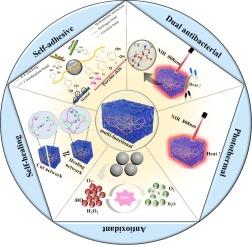Preparation and composition analysis of PVA/chitosan/PDA hybrid bioactive multifunctional hydrogel for wound dressing
IF 5.8
2区 化学
Q1 POLYMER SCIENCE
引用次数: 0
Abstract
An ideal wound dressing should possess self-healing, adhesion and adequate mechanical properties, as well as antioxidant, antimicrobial and biocompatible characteristics. In this study, we developed a self-healing highly adhesive, bioactive multifunctional composite hydrogel (PCP) with dual antimicrobial functions. The hydrogel was constructed using polyvinyl alcohol (PVA), chitosan (CS) and polydopamine nanoparticles (PDA) to achieve rapid wound healing. The one-pot method was utilized to blend these three raw materials at 95 °C, followed by the preparation of PCP with a dual physical network structure through a green freeze/thaw process. The incorporation of PDA nanoparticles not only endowed the hydrogel with excellent adhesion properties (46.7 kPa), photothermal properties (57.6 ℃, 0.6 W·cm−2), and DPPH scavenging ability (88.2 %), but also achieved more than 92 % inhibition against both Staphylococcus aureus (S. aureus) and Escherichia coli (E. coli) in synergistic effect with the bioantimicrobial agent CS (PCP3). Scanning electron microscopy (SEM) revealed that the microstructures of P, PC, and PCP hydrogels exhibited a dense and permeable pore structure, which facilitates the absorption and removal of wound exudate. Furthermore, thermogravimetric (TGA) analysis demonstrated that PCP hydrogels displayed good thermal stability. In vitro cytotoxicity test on human fibroblasts (L929 cells) indicated that all the hydrogels possessed superior cytocompatibility, with a maximum survival of 101 % for L929 cells. Additionally, cell scratch test confirmed that the hydrogel promotes cell migration, thereby accelerating wound healing. These results suggest that the bioactive multifunctional hydrogel holds significant potential as a wound dressing.

用于伤口敷料的 PVA/壳聚糖/PDA 混合生物活性多功能水凝胶的制备和成分分析
理想的伤口敷料应具有自愈性、粘附性和足够的机械性能,以及抗氧化、抗菌和生物相容性。在这项研究中,我们开发了一种具有双重抗菌功能的自愈合高粘附性生物活性多功能复合水凝胶(PCP)。该水凝胶由聚乙烯醇(PVA)、壳聚糖(CS)和聚多巴胺纳米颗粒(PDA)构建而成,可实现伤口的快速愈合。采用一锅法将这三种原料在 95 ℃ 下混合,然后通过绿色冻融工艺制备出具有双重物理网络结构的 PCP。PDA 纳米粒子的加入不仅使水凝胶具有优异的粘附性能(46.7 kPa)、光热性能(57.6 ℃,0.6 W-cm-2)和 DPPH 清除能力(88.2%),而且与生物抗菌剂 CS(PCP3)协同作用,对金黄色葡萄球菌和大肠杆菌的抑制率均超过 92%。扫描电子显微镜(SEM)显示,P、PC 和 PCP 水凝胶的微观结构呈现出致密和可渗透的孔隙结构,这有利于伤口渗出物的吸收和清除。此外,热重分析表明五氯苯酚水凝胶具有良好的热稳定性。对人成纤维细胞(L929 细胞)进行的体外细胞毒性测试表明,所有水凝胶都具有良好的细胞相容性,L929 细胞的存活率最高可达 101%。此外,细胞划痕试验证实,水凝胶能促进细胞迁移,从而加速伤口愈合。这些结果表明,生物活性多功能水凝胶作为伤口敷料具有巨大的潜力。
本文章由计算机程序翻译,如有差异,请以英文原文为准。
求助全文
约1分钟内获得全文
求助全文
来源期刊

European Polymer Journal
化学-高分子科学
CiteScore
9.90
自引率
10.00%
发文量
691
审稿时长
23 days
期刊介绍:
European Polymer Journal is dedicated to publishing work on fundamental and applied polymer chemistry and macromolecular materials. The journal covers all aspects of polymer synthesis, including polymerization mechanisms and chemical functional transformations, with a focus on novel polymers and the relationships between molecular structure and polymer properties. In addition, we welcome submissions on bio-based or renewable polymers, stimuli-responsive systems and polymer bio-hybrids. European Polymer Journal also publishes research on the biomedical application of polymers, including drug delivery and regenerative medicine. The main scope is covered but not limited to the following core research areas:
Polymer synthesis and functionalization
• Novel synthetic routes for polymerization, functional modification, controlled/living polymerization and precision polymers.
Stimuli-responsive polymers
• Including shape memory and self-healing polymers.
Supramolecular polymers and self-assembly
• Molecular recognition and higher order polymer structures.
Renewable and sustainable polymers
• Bio-based, biodegradable and anti-microbial polymers and polymeric bio-nanocomposites.
Polymers at interfaces and surfaces
• Chemistry and engineering of surfaces with biological relevance, including patterning, antifouling polymers and polymers for membrane applications.
Biomedical applications and nanomedicine
• Polymers for regenerative medicine, drug delivery molecular release and gene therapy
The scope of European Polymer Journal no longer includes Polymer Physics.
 求助内容:
求助内容: 应助结果提醒方式:
应助结果提醒方式:


